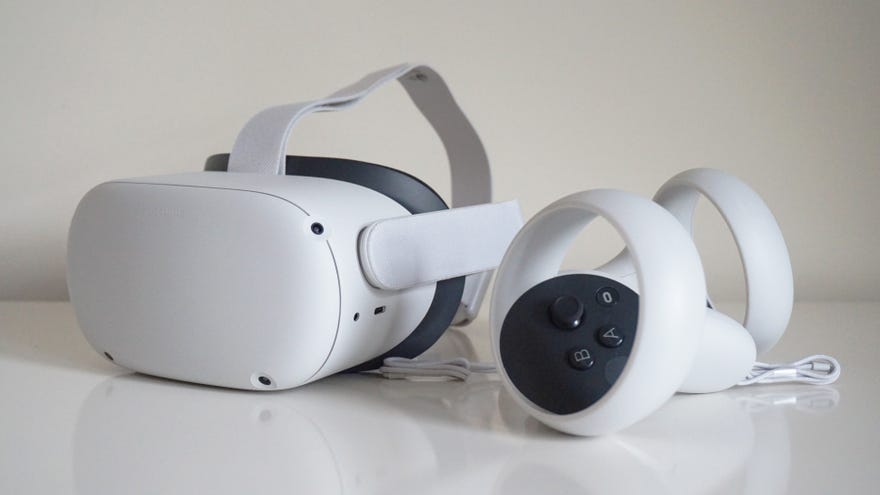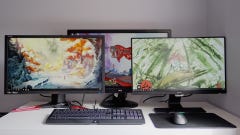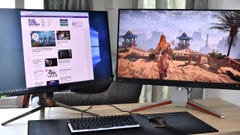Oculus Quest 2 review
A worthy if divisive successor to the Oculus Rift S
When I tested the Oculus Quest earlier in the year, it was one of the most freeing VR experiences I've ever had. It was also one of the most uncomfortable. Ditching the cable for wire-free VR is definitely the way forward as far as I'm concerned, but not when the headset in question crushes my nose, pinches my cheeks and makes me feel like I wanted to rip it off my head after just 30 minutes of use. Thankfully, the Oculus Quest 2 addresses all of these concerns and more.
Its lighter, slimmer chassis sits much more evenly on my head, and its redesigned strap makes it much easier to get a better, more comfortable fit. It also brings with it several key spec upgrades, a lower price, and that all-important flexibility to plug it into your PC via its Oculus Link technology if you want to take advantage of their more demanding Rift experiences. It's still not quite perfect, but with the imminent demise of the Rift S next year and no competition in sight from HTC's Vive headsets, the Quest 2 is almost certainly the best low-cost VR headset you can buy right now - as long as you don't mind creating a Facebook account for it, that is.
Oculus Quest 2 review in a nutshell
The good...
- Much more comfortable to wear than the original Quest
- Sharper display offers a noticeable visual upgrade
- The base model is cheaper than the original
The bad...
- Requires a Facebook account to use it
- Still makes your head ache after a while
- Widespread support for its higher 90Hz refresh rate hasn't arrived yet
Indeed, the Quest 2 is the first of Oculus' VR headsets that will require you to log-in via a Facebook account if you haven't owned an Oculus headset before. Existing users will still have the option to log-in via their Oculus accounts, but as per Facebook's announcement in August, support for Oculus accounts will end on January 1st 2023. Instead, they're now encouraging users to merge their Oculus and Facebook accounts together so they can continue to have full functionality of their headset.
Now, as someone who deleted their Facebook account in light of the Cambridge Analytica scandal, this news came as a big disappointment. The last thing I wanted to do was create another Facebook account, and there's still a part of me that's annoyed I've had to do so to test the Quest 2.
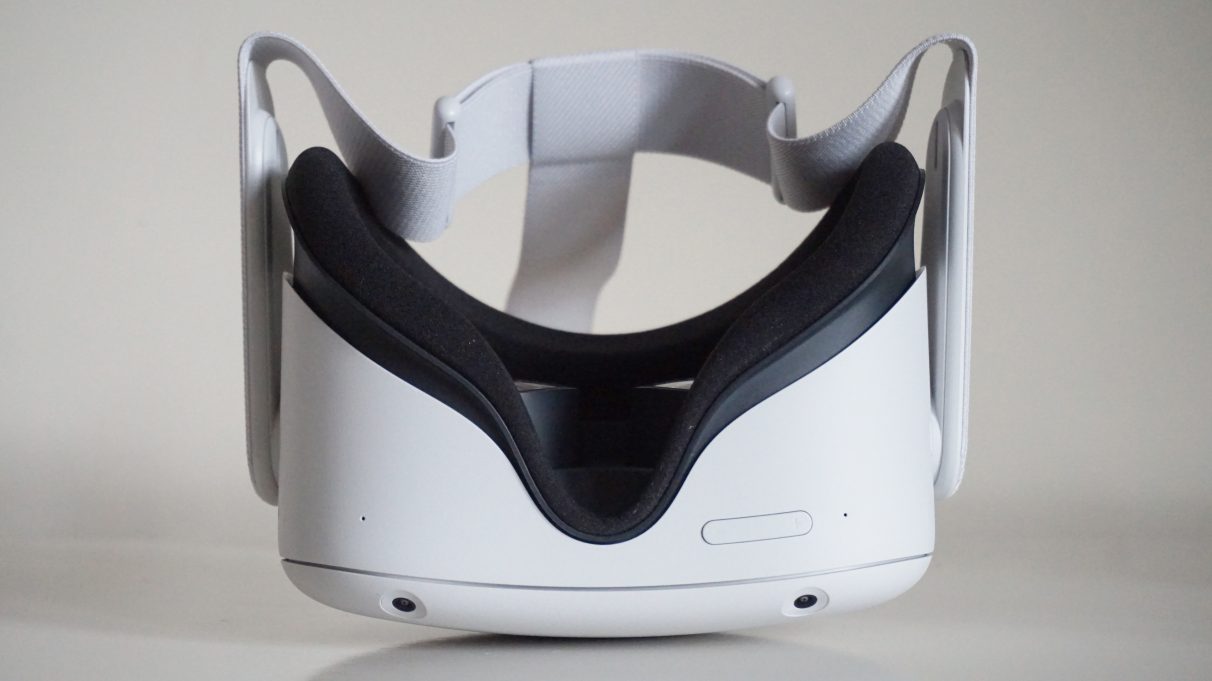
That said, I also haven't had to have any interaction with said Facebook account apart from filling in my name, date of birth and email address. I didn't need to make any friends, I didn't need to add a profile picture, nothing. It's the barest of bones profile you could possibly imagine, and I'm okay with that. It's an acceptable level of irritation I'm willing to put up, especially when the current state of VR headsets effectively boils down to paying £299 / $299 for the Quest 2, or going all out on the £919 / $999 Valve Index due to ongoing disaster zone that is the HTC Vive Cosmos.
Oculus Quest 2 and Oculus Link
As with the original Quest, you'll need to spend a little extra on the Quest 2 if you want to make use of its best feature: its Oculus Link tech. You'll have to sacrifice its wireless capabilities in the process, but Oculus Link lets you connect the headset to your PC via a high-speed USB cable so you can use your Quest 2 to play all sorts of other VR games you won't find in Oculus' dedicated Quest store. This includes Oculus Rift games, as well as Steam VR games such as Half-Life: Alyx, and even a handful of HTC's Viveport titles, giving it the most versatile VR library around.
Your PC will need to meet certain requirements in order to use Oculus Link, and you can find out more about the actual steps involved in getting your Quest 2 to work on PC using my dedicated How to play Half-Life: Alyx on the Oculus Quest guide. In short, it's very easy to setup and you only need the three things listed below to get started.
Oculus Link requirements:
- a compatible graphics card (most of Nvidia’s GTX 10-series cards such as the GTX 1060 will work, as will the older GTX 970 and all their RTX-20 series cards, and all of AMD’s RX 400 series cards onwards have been approved for use as well)
- a VR-ready PC (Oculus recommend at least an Intel Core i5-4590 or AMD Ryzen 5 1500X CPU, 8GB of RAM and an Nvidia GTX 970 or AMD Radeon RX 470 graphics card)
- a high-speed USB-C to USB-A cable
Just like the original Quest, Oculus have their own very expensive Link cable for the occasion if you've got a spare £89 / $89 lying around, but you can also use approved third-party cables as well, such as the infinitely cheaper £13 / $17 Anker 10ft Powerline cable (which is also the one I used for all of my own Oculus Link testing).
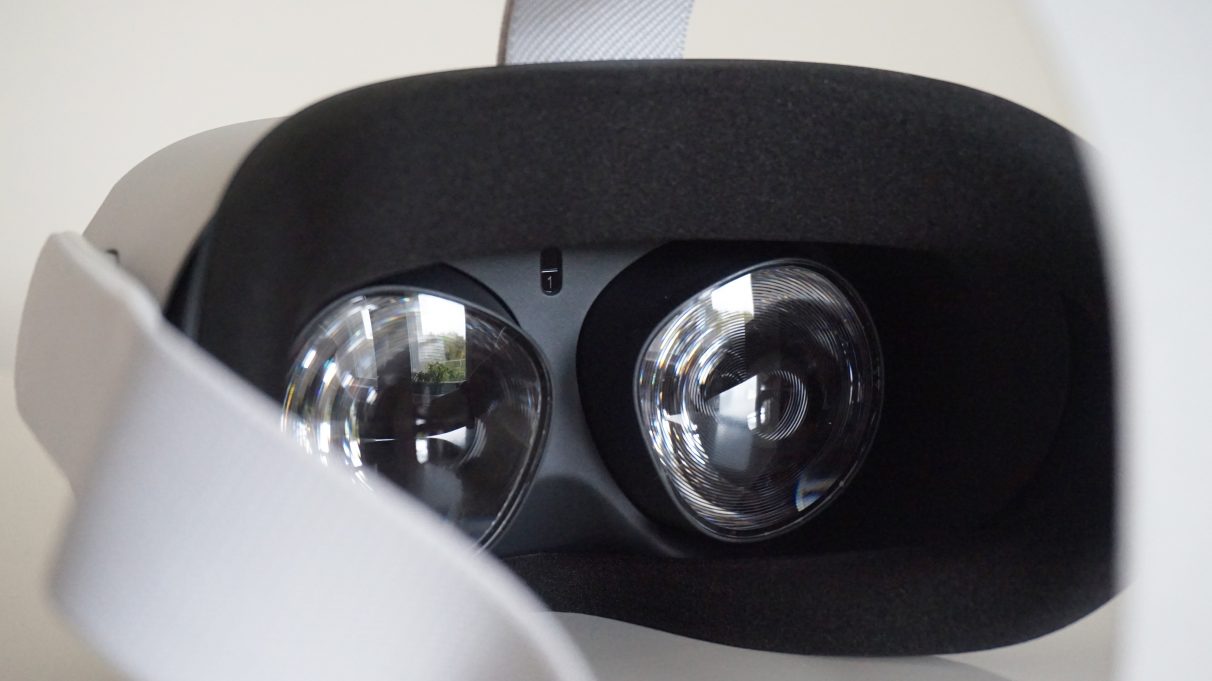
That said, Oculus' Link cable does come with some advantages. For starters, the port that connects to the headset is angled at 90 degrees, meaning it doesn't stick out and potentially get in the way of your left arm when you're moving about. Secondly, Oculus have finally included a headset tie on the Quest 2's Link cable, so you can feed it behind your ear and snake it over your shoulder much like the cable on the Rift S and Valve Index - which again cuts down on any potential arm tangles.
I'd imagine this extra cable tie will also help prevent the headset from becoming too unbalanced as well, as I found that the sheer weight of my Anker cable actually made the headset very lopsided when I tried playing Half-Life: Alyx with it. Whereas previously the headset had fitted perfectly fine for playing its wire-free Quest games, I quickly had to adjust the rear head straps to make sure it actually sat horizontal on my face again.

The official Oculus cable is also a proper USB 3.2 Gen 1 cable, whereas my Anker cable is only a USB 3.0 one, which may not be enough to support the Quest 2's new 90Hz refresh rate. I wasn't able to test this before launch as even Oculus have said it will take time for games to get updated to support the Quest 2's newly bumped up refresh rate, but I will be taking a closer look at this as soon as I can.
The Oculus one is a fraction longer as well, measuring 16ft instead of 10ft, which gives you just that little bit of extra leeway to comfortably sit back on your sofa, for example, rather than being forced to sit right on the edge of my seat like I was when using my Quest 2 in the living room. As a result, there are clear advantages with going with Oculus' admittedly ludicrously priced cable, and my Anker definitely felt like a bit of a cheap compromise during my testing.
Still, even as a cheap compromise, the ability to have the best of both worlds when it comes to VR games is arguably even better on the Quest 2 than it was on the original. While the Valve Index remains the pinnacle of PC-based VR headsets, offering a far sharper and smoother-looking picture and wider field of view in Half-Life: Alyx than the Quest 2 (if only because of the data compression limitations enforced by the USB cable), the Quest 2 is still an excellent headset for playing the best VR games on PC, and its lighter and more ergonomic design of Oculus' new headset means it's much more enjoyable to wear in the process.
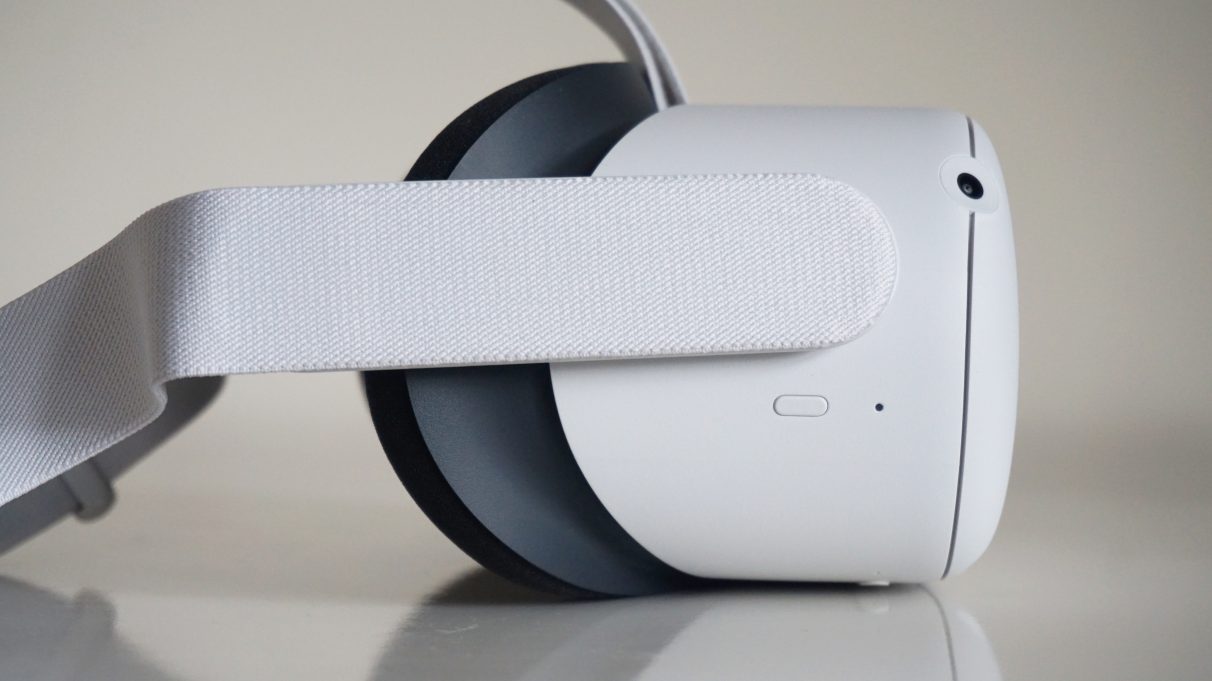
Oculus Quest 2 design and comfort
Whereas before I was itching to get the original Quest off my face after a maximum of 30 minutes, I found I could wear the Quest 2 for well over an hour. That's still not brilliant, all told, at least not compared to the several hours I can wear the Index for, but it's long enough to feel like I've done a proper gaming session with it.
The main obstacle getting in the way of longer play sessions is, ironically, one of the steps Oculus have tried to take to make it more comfortable. Before, the Quest had a horrible rubber head strap that didn't offer any kind of adjustment beyond its basic trio of velcro straps. Due to my smaller than average head (at least according to tech designers, it would seem), this made the original Quest feel very top-heavy, as there was nothing to help anchor it round the back of my head. This put all the weight on the bridge of my nose, and its lack of additional padding made it quite unpleasant to wear.
This time, Oculus have redesigned the Quest 2 to try and address this. The over-the-top velcro strap remains, but there are now two plastic nubbins toward the back of the head strap that you can adjust to make it looser or tighter. Together with the thicker foam padding at the front of the headset (especially around your nose and cheeks) and the hard adjustment arms you can move up and down to bring it closer to your face, these new design tweaks do indeed go a long way to help making the Quest 2 more comfortable.
For all the improvements they make, though, they're still not as elegant or as practical as the adjustment dials you'll find on the Rift S or Index. You see, it's those darn plastic nubbins that are the cause of my "get this thing off my face" woes, as these really start to dig into the back of my head once I approach the 80-90 minute mark. Even with the benefit of having long and reasonably thick hair, I came away from each play session with quite a sore head, and a rather unseemly red mark on my forehead. Instead, you'll have to shell out another £49 / $49 for the "Elite Strap" if you want that coveted dial, which feels a bit stingy if you ask me.
As a result, I can't help but feel like the design changes on the base Quest 2 are very much a two steps forward, one step back kind of affair. Instead of just making the best possible headset, it feels like Oculus have made a series of compromises here for the sake of having a lower overall price, portioning off the best bits into expensive add-ons. I'll take painful nubbins over a raw nose any day of the week, but I'd also prefer to just pay a bit more and have the dial as standard rather than feel like I'm spending more than I need to.
Oculus Quest 2 hardware specs - does it improve on the original Quest?
Thankfully, the rest of the Quest 2's spec improvements are much more welcome. The increase in per-eye resolution from 1440x1600 to 1832x1920 makes everything look and feel that much more detailed and immersive, and the option of having more storage (a whopping 256GB) for the same amount of money as the original Quest (£399 / $399) is always going to be a win in terms of value for money, too. Plus, once developers start adding in support for its higher 90Hz refresh rate, games will eventually feel just as smooth as HTC's considerably more expensive Vive Cosmos headsets - which is pretty good going for a headset that starts at £299 / $299 for the base 64GB version.
I can't say I really felt what its new Snapdragon XR2 chipset and 6GB of RAM were bringing to the table, admittedly, but that's probably because most of the games I was testing on the Quest 2 are the same ones available on the original Quest. Some have been updated to make better use of the Quest 2's extra performance boost, but there are only a handful of these so far, and even then I'm not sure I could tell the difference.

As a result, it may be some time before we see developers making the most of the Quest 2's nippier hardware - including its 90Hz refresh rate - as the only upgrade I'd say you can really feel and appreciate right now is the bump in resolution. Otherwise, it's a very similar experience to what you'd get on the original Quest. That's hardly a problem for new Quest buyers, of course, but for existing owners I can't really see much reason to upgrade unless, like me, you're tired of having a sore nose all the time and want to be able to play VR games for longer.
Thankfully, the Quest 2's six degrees of freedom tracking technology remains as excellent as ever, working just as well in my brightly lit home office as it did in the gloom with the curtains closed. I never experienced any hand drifting or tracking judder either, which is more than can be said for the Vive Cosmos.

The refreshed Touch controllers are just brilliant to use as they were before, too. These have only received a very light redesign compared to the original Quest controllers, somehow making them even more ergonomic than they were before, but otherwise they're pretty much unchanged. They're still wonderfully light to hold for long periods of time, and their tactile buttons and joysticks cement their place as the second best VR controllers after Valve's Index Knuckles.
The same goes for the Quest 2's integrated speakers. These haven't diminished in volume or quality since the original Quest, making them excellent companions for whatever type of VR game you want to play. There's very little need for extra off-ear, Index-style headphones when you've got speakers like these, and I was able to bop away quite merrily to the likes of Beat Saber and Tetris Effect while feeling completely immersed in what I was doing. You can plug in a pair of 3.5mm headphones if you need to be a bit more considerate of those around you, but otherwise these are more than enough to get the job done.

Should you buy an Oculus Quest 2?
With the sun soon setting on the Oculus Rift S (and Facebook's forays into PC-based VR in general), the Quest 2 is very much the natural, if slightly awkward successor to its best VR headset crown. While there are still some design kinks I hope get ironed out for the inevitable Quest 3 (come on, Facebook, let's have that adjustment dial as standard next time and not an expensive accessory), its higher resolution display, faster refresh rate and lighter, more ergonomic chassis do make it a much better headset than the original Quest, especially when its base 64GB model costs £100 / $100 less.
Yes, there's the whole mandatory Facebook account issue, but as I said earlier, your relationship with the social network company doesn't need to go any further beyond setting up your initial profile. Whatever your feelings are about Facebook, there's no denying that the Quest 2 sets a high bar for entry-level VR, and the option to pick and choose between wireless and tethered PC VR gives you a lot more for your money than rival headsets. It's a shame the Rift S has to die as a result, but it also makes perfect sense. After all, why have a solely PC-based headset when you connect a wireless one via Oculus Link and do both for less?
The Oculus Quest 2 is a great introduction to VR, and almost certainly the headset most people should buy going forward. The Valve Index remains the absolute bestest best VR headset for PC if you've got the money for it, but at £919 / $999, it's also a much bigger investment. The Quest 2, on the other hand, is cheap, relatively cheerful, and a much better way of experiencing what PC VR has to offer without breaking the bank.
